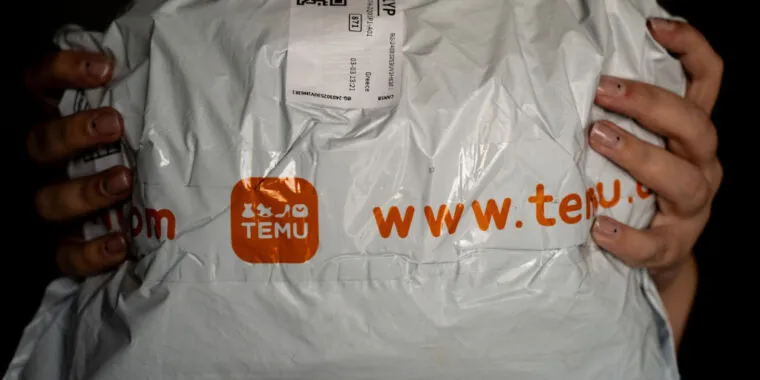Temu—the Chinese shopping app that has rapidly grown so popular in the US that even Amazon is reportedly trying to copy it—is “dangerous malware” that’s secretly monetizing a broad swath of unauthorized user data, Arkansas Attorney General Tim Griffin alleged in a lawsuit filed Tuesday.
Griffin cited research and media reports exposing Temu’s allegedly nefarious design, which “purposely” allows Temu to “gain unrestricted access to a user’s phone operating system, including, but not limited to, a user’s camera, specific location, contacts, text messages, documents, and other applications.”
“Temu is designed to make this expansive access undetected, even by sophisticated users,” Griffin’s complaint said. “Once installed, Temu can recompile itself and change properties, including overriding the data privacy settings users believe they have in place.”



Em… writing a different manifest and asking the OS to reinstall itself, is not rocket science. Detecting that it’s running in a testing environment and not asking for permission to access some types of data, is also quite easy. Downloading a different update or modules depending on which device and environment it gets installed to, is basic functionality.
It’s still sneaky behavior and a dark pattern, but come on.
Uh, as someone who does malware analysis, sandbox detection is not easy, and is certainly not something that a non-malware-developer/analyst knows how to do. This isn’t 2005 where sandboxes are listing their names in the registry/ system config files.
I haven’t done sandbox detection for some years now, but around 2020, it was already “difficult” as in hard to write from scratch… yet already skid easy as in “copy+paste” from something that does it already. Surely newer sandboxes take more stuff into account, but at the same time more detection examples get published, simply advancing the starting point.
So maybe TikTok has a few people focused on it, possibly with some CI tests for several sandboxes. I don’t think it’s particularly hard to do 🤷
I found at least one of the posts, and you’re right, that’s not really what impressed them. It just stuck with me because I’m a hardware girl.
There is some irony to be had, in discussing this stuff on a page that starts by asking me to login, then to be good and disable my ad blocker, only to proceed with keeping half the text of the article as images so you can’t copy+paste it… and even all the comments!
Anyhow…
😈 Thanks for telling us where you got the link from, I didn’t really care. 😁
Static backup (possibly): https://archive.is/UD2SA
Check out: https://amiunique.org/fingerprint
No app needed!
Using that as a baseline… the CPU type, memory usage, disk space, etc. are some extra data points freely available to all apps.
A developer can distribute an app with multiple versions, some targeting more modern and capable devices, some older and more limited. It’s a feature, not a bug!
This is overreaching for an app that has nothing to do with managing other apps. Still, you may want some app with those capabilities… so let’s call it “sus”.
Your IP is… well, you’re using it to connect, they will see it, duh.
The rest is overreaching and comes into PI violation terrain, but can be used for geo location… the OS does it, that’s the data it uses to fine-tune the GPS’s location.
Typical feature for banking ad DRM protected apps. Nothing to see here.
Best answered by a comment [1] (SEE BELOW).
TL;DR: more DRM stuff.
This is somewhat sus, but a local proxy by itself, doesn’t mean any sort of risk, or that it could be exploited.
For example, Tor can be accessed using a local proxy (although VPN mode is safer).
Not exactly. It’s how feature flags, and remote testing/debugging works too.
This is worse (why do they use a custom OLLVM fork?), and obfuscation usually means they have something to hide. It’s the opposite of security for the user.
Not good, but unfortunately allowed. That behavior is shared by both DRM protected software, and malware.
False.
There are two legitimate reasons: plugins, and DLCs.
It can be used for shady stuff, but is also a “feature, not a bug”.
Well, that’s just stupid, there is zero reason to send data unencrypted.
Ehm… this is the correct behavior. See previous point.
Sus… but see the introductory part of this comment. Should boredpanda also be banned?
This is bad, and a reason to use FLOSS apps… but since it’s been an accepted behavior for Privative Software, along with DRM… don’t blame the player, blame the game.
No, seriously, blame the DMCA and friends. There is no way to at the same time “enforce DRM, keep a copy of all keys at a trusted third party, and keep users secure”… so the current situation is “you get none of those”.
[1]
Thanks for the analysis and insight!